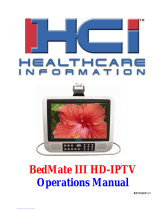
4
Table of Contents
Important Information .................................................... 2
IMPORTANT SAFETY INSTRUCTIONS ................................
3
Chapter 1: Connections & Setup 5
Chapter 1: Connections & Setup .......................5
Things to Consider Before You Connect ......................... 5
Protect Against Power Surges ................................... 5
Protect Components from Overheating ................... 5
Position Cables Properly to Avoid Audio
Interference ................................................................ 5
Important Stand and Base Safety Information ......... 5
Use Indirect Light ....................................................... 5
Things to Consider Before You Connect ................... 5
Front Input Jacks ...............................................................
6
Front Panel Buttons ................................................... 6
Hospital Pendant ........................................................ 7
Explanation of Jacks and Cables ...................................... 7
Plug in the TV ............................................................. 8
Start-up .............................................................................. 8
Put Batteries in the Remote ...................................... 8
Turn on the TV ............................................................ 9
Place All Available Channels Into Memory .............. 9
Set the Time ............................................................... 9
The ClonePRO™ ............................................................... 9
Understanding the Menus ............................................ 10
Master Menus ........................................................... 10
Basic Menus .............................................................. 10
Using Master and Basic Menus ...................................... 10
Exiting a Menu ......................................................... 10
Setting Limits in Master Menus ............................... 10
Sound Menu .................................................................... 11
Picture Menu ...................................................................
12
Access and Power Options Menu .................................. 12
Parental Control ..............................................................
14
Time Menu ....................................................................... 15
Setup Menu ..................................................................... 16
Chapter 2: Using the Remote Control 17
Chapter 2: Using the Remote Control ............17
Types of Remote Controls .............................................. 17
Basic Remote Buttons (CRK17TC1 & CRK17TD1) ........... 17
Additional Remote Buttons (CRK17TD1) ....................... 18
Using the INPUT Button .................................................. 19
Using the SYSTEM Button .............................................. 19
ClonePRO™ Remote Buttons ......................................... 20
Chapter 3: Using the Menu System ................21
The Basic Menu System .................................................. 21
Sound Menu ............................................................. 21
Picture Menu ............................................................ 21
Channel Guide Menu ............................................... 21
Parental Control Menu ............................................ 22
Time Menu ................................................................ 22
Language & CC Menu .............................................. 23
The TV can be "Decommercialized" ...............................
23
Chapter 4: Using the TV's Features .................24
Channel Banner ............................................................... 24
Parental Controls and V-Chip ......................................... 24
How V-Chip Works ................................................... 24
USA V-Chip Rating System ....................................... 25
Canadian English V-Chip Rating System ................. 25
Canadian French V-Chip Rating System .................. 26
USA V-Chip TV Rating Limit ................................... 26
Blocking Specific Content Themes .......................... 28
Viewing Specific Content Themes ........................... 28
Blocking Canadian V-Chip Ratings .......................... 28
V-Chip Movie Rating Limit ....................................... 29
V-Chip Exempt Program Block .............................. 29
KidPass ...................................................................... 30
Front Panel Lock ....................................................... 30
Create Password ....................................................... 30
Chapter 5: Other Information .........................31
Using the ClonePRO™ .................................................... 31
Modes of operation ................................................. 31
DSCI mode ................................................................ 31
IR mode ..................................................................... 32
Cloning a TV ............................................................. 33
Troubleshooting ..............................................................
34
Limited Warranty ............................................................
37
Accessories ...................................................................... 39
1651024A 4 6/2/05 2:52:21 PM




















